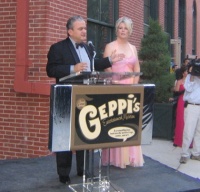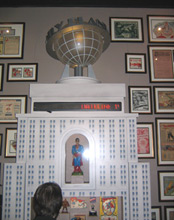
The word of the night was 'overwhelming' at the inaugural gala celebrating the opening of Geppi's
The attendees, most of whom had spent lifetimes in the comics business with the personal accumulations of collectibles that implies, were universally floored by the scale and scope of the Museum's collection. We heard the word 'overwhelming' at least a half dozen times, from a wide range of attendees.
Retailer Chuck Rozanski of Mile High Comics, certainly no stranger to amazing collectibles, told us, 'My voice was getting squeaky while I was looking at this stuff, and my voice doesn't get squeaky.'
Geppi called a number of celebrity attendees to the podium before he cut the ribbon, including Martin Luther King III (a display of items celebrating the life of his father is one of the exhibits); Jerry Robinson, who Geppi described as 'the guy who made Batman what he was;' Frank Frazetta, 'one of the greatest fantasy illustrators of all time;' Brian Walker, representing his father, Mort (Beetle Bailey) Walker (who arrived later); and Paul Levitz, CEO of DC Comics.
'This is my opportunity to show my collection,' Geppi said. 'We have accumulated quite a lot of stuff,' he continued in a massive understatement.
Once the ribbon was cut, attendees had a chance to view the roughly 7,000 items on display, most from Geppi's personal collection. The collection covers over 250 years, showcasing the entire history of comics and its predecessors, as well as movies, television, music, and character goods.
The comics, of course, are central, with beautiful copies of all the key books in comics history, ranging from Famous Funnies to Action #1 and Detective #27, the first Disney Comics, a great display of early promotional comics, many key ECs, and continuing up through the present day. The early Superman books, along with a number of the earliest Superman collectibles, were displayed in a replica of the Daily Planet building, complete with a ticker displaying news headlines from the 40s across the top.
Newspaper strips were also well represented, with original art from every key strip on display. Among the most unique displays was the art for the final Krazy Kat strip by George Herriman, in which the title character dies. It was hung next to a framed letter from Walt Disney to Herriman's daughter, offering his sympathy on the death of her father (who passed away shortly after the final strip was drawn), and describing the influence and importance of Herriman's work.
One of the oldest pieces was a 1754 editorial cartoon by Benjamin Franklin, 'Join or Die,' on a page of The Pennsylvania Gazette newspaper. It is the only copy in private hands, and is valued at $185,000.
But the comics actually appear to comprise a minority of the collection, and in every category, similarly significant pieces are on display. A spectacular collection of movie posters in unbelievable condition, ranging from numerous Disney cartoon posters to King Kong to The 10 Commandments to War of the Worlds to Superman and Batman serials, was hung throughout the museum.
TV collectibles, including a fantastic display of Howdy Doody pieces, were also spectacular. A section displaying toys from the Westerns (e.g., Hopalong Cassidy guns, gloves and other costume pieces) took this writer back to the 50s, when the Wild West was king.
Rock and roll posters, including some fantastic Fillmore posters, were a small but significant part of the music collection, which also included numerous toys featuring pop music celebrities from the past 50 years.
Interactive displays, including opportunities to view early comics on-screen, and an introductory video with Geppi talking to visitors, were scattered throughout the museum.
Geppi didn't sound like a man who was done adding to his collection. 'The goods you have are dead,' he said. 'The goods you don't have are alive.' His Diamond International Galleries, a smaller museum in the same building as the Diamond Comic Distributors headquarters, is reportedly more full than it was a few years ago. We asked him what percentage of his personal collection was now on display, and he just shook his head.
Geppi's
George Gene Gustines gave it some great national press in Wednesday's New York Times, where his article, with a number of illustrations, appeared on the cover of the arts section.
With press like that from the mainstream, and what will surely follow as more people visit the museum for the first time, Geppi's Entertainment Museum is likely to become nationally and internationally renowned as the place to go to see the history of pop culture in America. It opens to the public today, Friday, September 8th.




